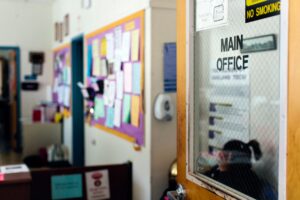
Black teachers: How to recruit them and make them stay

Lessons in higher education: What California can learn

Keeping California public university options open

Superintendents: Well-paid and walking away

The debt to degree connection

College in prison: How earning a degree can lead to a new life

It’s been almost two years since Bill Gates announced a major shift to locally driven solutions in the education funding strategy of the Bill and Melinda Gates Foundation, the nation’s largest charitable foundation.
Gates said he remains “driven by the same guiding principle we started with: all students — but especially low-income students and students of color — must have equal access to a great public education that prepares them for adulthood.”
As Gates vowed in the speech to the Council of the Great City Schools in Cleveland, “We will not give up until this has been achieved.”
The result is a first round of funding totaling $93 million from the foundation to 21 local Networks for School Improvement committed to continuous improvement and uncovering changes that will make a difference for black, Latino and low income students.
Early glimpses of the results of the work funded by the foundation over the last year were unveiled Tuesday at the University of Maryland to more than 300 attendees, including educators engaged in funded projects and others expecting to join in. A report of the first year of the initiative was also released detailing the projects underway.
“We want to share what we’re learning as quickly as possible,” Bob Hughes, director of the Gates foundation’s K-12 education, told the audience at the Networks for School Improvement: Year One Review Event. The hope, he added, is that educators pick up what others are doing and try it in their own schools.
Hughes said he hoped that what develops “is a movement to try to really improve what happens for African-American, Latinx and low-income students. We have to do that.”
Within the next two months, the foundation plans to announce a new round of grants for networks to join in the effort.
“Our hope is that these networks become a prototype to scale innovative practice and implement it in ways that ultimately decrease and eliminate the achievement gap across the country,” said Hughes.
Networks for school improvement consist of a supporting organization such as a nonprofit, university or school district that connects middle and high schools to work together as a network. Their goal is to improve student outcomes by identifying barriers to student success and common problems that they can work on. The network uses data to help identify the problem and the strategy to solve it. Data also help to monitor improvement on whether students are graduating from high school and successful in college.
The emphasis on funding local collaborations of teachers and schools working together to come up with their own solutions represents a radical departure from the foundation’s earlier national initiative networks, such as promoting the Common Core standards in math and English language arts, tying teacher evaluations to measures of student “growth,” including test scores, and supporting “small schools.”
In announcing the new strategy in late 2017, Gates committed the biggest share of the $1.7 billion that the foundation planned to spend on K-12 education to this effort, which focuses on using data to come up with locally driven solutions.
The networks are working with 298 middle and high schools in more than a dozen states nationwide, including California. The schools enroll 250,000 students, 29 percent of whom are black, 43 percent Latino and 70 percent low-income.
Hughes said the Gates foundation has committed funding for five years, after which a decision will be made on whether to expand, stay the course or stop. Additional California projects will be included in the next round of funding, Hughes told EdSource.
Gates’ emphasis on local initiatives seems consistent with the major thrust of California’s education reforms in recent years, embodied in the Local Control Funding Formula, which also has devolved more decision-making to local school districts.
Included among the initial 21 projects are four California nonprofit organizations.
The High Tech High Graduate School of Education in San Diego is partnering with up to 30 charter and traditional high schools in Southern California. The aim is to increase the number of black, Latino and low-income students who apply and then attend a four-year college.
So far, the network includes five High Tech High schools, two independent charter schools and 11 comprehensive high schools from seven districts in northern San Diego and Southern Los Angeles.
It will focus on key factors that affect college enrollment: access to financial aid, the college application process, fostering a sense of belonging in college and reducing “summer melt” — students’ failure to enroll even after they have been admitted.
The graduate school is part of the High Tech High organization, which began in 2000 as a small charter school in San Diego.
California Education Partners, based in San Francisco, is creating a network of 50 high school in 18 small and mid-sized districts to improve achievement among black, Latino and low-income students. The grant is aimed at expanding the Ed Partners’ capacity to design, lead and evaluate collaborations of schools focused on improvement. Ed Partners also led the 5-year, 10-district Math in Common project whose goal was to improve instruction of the Common Core math standards.
CORE Districts, based in Sacramento, are eight California school districts, including Los Angeles, Oakland, Fresno and Long Beach, serving a million students, that work together on strategies to narrow achievement gaps. The grant will focus on CORE’s work to ensure that 9th-graders are on track for graduation and college enrollment, its student data system and its partnership with the research nonprofit Policy Analysis for California Education.
Teach Plus, a national organization with offices in several regions, including Los Angeles, builds teacher leaders with instructional expertise. The grant will create a network of 10 middle schools in Chicago and Los Angeles that will guide the work of teacher leaders and principals to increase 8th-grade math proficiency of black, Latino and low-income students.
During the event Tuesday, the Baltimore City Schools offered a glimpse of the stakes in this effort. Their focus is on middle and high school students who are not reading at grade level and certainly not a level that will bring them success in college or beyond. As a video on the project poignantly described, the inequities faced by these students reflect the zip codes they live in.
Zachary Jaffe is a literacy coach who works daily with educators and students to uncover the changes that need to be made to improve learning for these students. In the video, Jaffe said the challenge is not to jump to a quick fix — “solutionitis” — but to listen to what students say they need.
Interviewing students and studying performance data are two pillars of this continuing improvement approach. Mostly, it is acknowledging that there are no quick fixes or magic bullets. The solutions come out of hard, slow work that continuously builds on success.
As the participants learned, it’s the kind of approach that has proven successful in other sectors like health care and manufacturing. With the right changes, the strategies can work in education. That’s what the Gates Foundation is counting on as it puts the force of its expertise behind this effort.
Among the challenges, Hughes told them, is to search for the root cause.
As an early practitioner, Baltimore City will surely become a test case for the strategy. Baltimore City Public Schools CEO Dr. Sonya Santelises said her team has been working on this strategy for about eight months and her staff is telling her that this already “feels differently” than other top-down efforts.
And while 20 to 30 schools have worked on improvement, Santelises says she needs a process that will serve all of the students in the district’s 170 schools. Their work has “only just begun.”
In some districts, that work includes confronting the history of segregation that has resulted in inequities in facilities and resources, speakers said.
When asked in a panel discussion to identify the one unsolved thing that keeps her up at night, Michelle Bowman, associate director, communities for Learning Forward, which trains educators in professional development, responded: “Are we willing to engage in the conversations around race and racism?”
Added Rosa E. Apodaca, interim executive director & senior fellow at the Institute for Learning at the University of Pittsburgh, said: “That’s it folks. We really have to engage in that conversation and people only like to engage in it at a level where it is not going to hurt…I’ve seen how people retract from it when they don’t like it or they feel like it hurts.”
EdSource reporter John Fensterwald contributed to this report.
EdSource receives support from a dozen philanthropic foundations, including the Gates Foundation. Editorial decision-making and content remain under the sole control of EdSource.

Panelists discussed dual admission as a solution for easing the longstanding challenges in California’s transfer system.

A grassroots campaign recalled two members of the Orange Unified School District in an election that cost more than half a million dollars.

Legislation that would remove one of the last tests teachers are required to take to earn a credential in California passed the Senate Education Committee.

Part-time instructors, many who work for decades off the tenure track and at a lower pay rate, have been called “apprentices to nowhere.”
Comments (2)
Comments Policy
We welcome your comments. All comments are moderated for civility, relevance and other considerations. Click here for EdSource's Comments Policy.
Dan Plonsey 5 years ago5 years ago
The primary cause of the achievement gap is economic inequality. Racism is also a significant factor. So now here's Bill Gates, the poster boy for economic inequality, unable to figure out how to close the gap. It's frustrating to read one uncritical article after another about Gates, Eli Broad, and all the other "philanthropists" whose meddling in education has only made things worse: Broad is a big supporter of charters, and Gates' support - and … Read More
The primary cause of the achievement gap is economic inequality. Racism is also a significant factor. So now here’s Bill Gates, the poster boy for economic inequality, unable to figure out how to close the gap. It’s frustrating to read one uncritical article after another about Gates, Eli Broad, and all the other “philanthropists” whose meddling in education has only made things worse: Broad is a big supporter of charters, and Gates’ support – and then sudden withdrawal of support – for small schools, caused great damage, as schools could no longer afford the model they’d been led to commit to. No, improving schools is not like improving manufacturing. And access to quality health care is dependent on one’s wealth, thus there is still a huge gap by race in health, comparable to that in education. These outcomes are due to inequality — so let’s end inequality directly.
Cheryl Votruba 5 years ago5 years ago
Glad to hear about these programs. One thing that needs to be addressed is the lack of structured literacy for struggling readers. We are a low-income family in Santa Clarita, CA, and no students are being given appropriate intervention to close the achievement gap in reading. My 4 boys have leaning disabilities and dyslexia. Despite IEPs and low-income, free-lunch program, I’ve had to search out a non-profit agency that would review my … Read More
Glad to hear about these programs. One thing that needs to be addressed is the lack of structured literacy for struggling readers. We are a low-income family in Santa Clarita, CA, and no students are being given appropriate intervention to close the achievement gap in reading.
My 4 boys have leaning disabilities and dyslexia. Despite IEPs and low-income, free-lunch program, I’ve had to search out a non-profit agency that would review my son’s educational records and file due process complaints against the school districts here. They are not willing to provide structured literacy to struggling readers in the schools, to students with IEPs or low income students who are struggling readers. They offer summer school with more if the same curriculum that does not work!
At our neighborhood school less than 50% of students are reading at grade level. Yet the schools have not modified their curriculum or teaching strategies for the 50% of students reading below grade level. After advocating for my children all year long, they ended the school year with minimal reading progress. One son gained no new skills all year. He’s still testing at the same reading level as he did before last summer. A whole year of school and no reading progress. My older son made 3 months of reading progress in a school year so now he too is further behind in his reading level than he was a year ago. I don’t know what these school districts and SELPA do with the millions of dollars they are getting for low income and struggling readers. But I can tell you the money isn’t reaching the students who need it.
The percentage of students reading below grade level is proof. As for me and my boys, I have an attorney through a non-profit organization to go up against the district-hired attorneys who are paid with our tax dollars to help the district deny my boys the chance to learn to read. Yes, school districts use taxpayer money to litigate against parents who insist their children be educated and be taught how to read, spell and write. Also, I have had to spend hundreds of dollars on a specialized reading program so that I can train myself to teach my boys how to read using a structured literacy program. I have to do this to get them as caught up as much as possible over the summer to make up for the lack of appropriate reading programs at the schools and lack of progress reading progress at school. Using time and money that a low income family should not be forced to use on purchasing reading intervention when we are struggling to put food on the table and struggling to maintain adequate housing.
This is the sad but true reality of life in Santa Clarita and how educational funds are being misused and are not reaching the students those funds were meant to help. I hope someone hears our outcry and helps us do something about the misuse of education funds at these schools and the lack of structured literacy for all struggling readers here. Especially low income students whose parents don’t have the money to hire private tutors to get their children caught up to grade level.